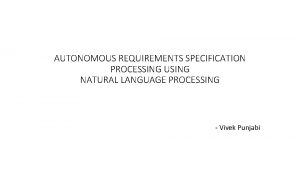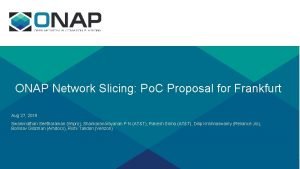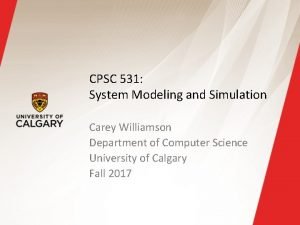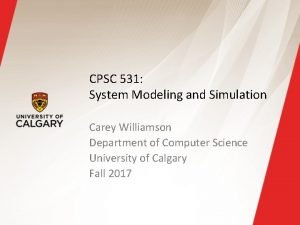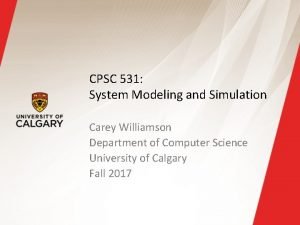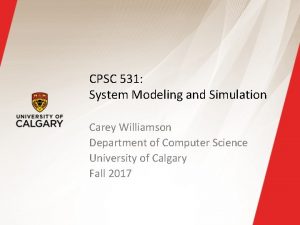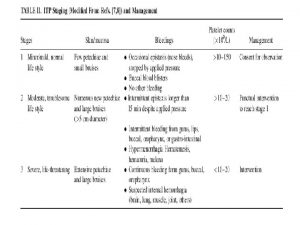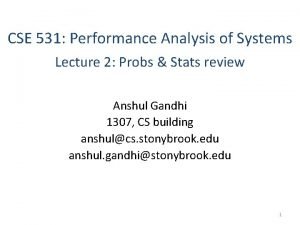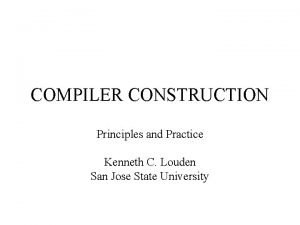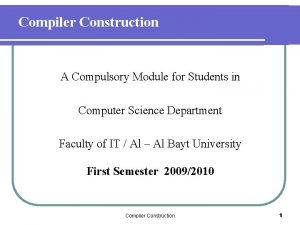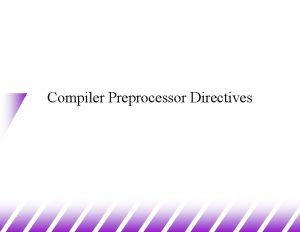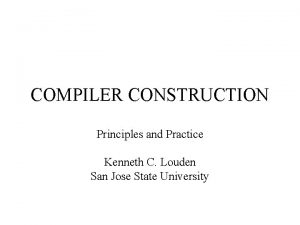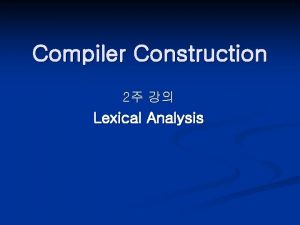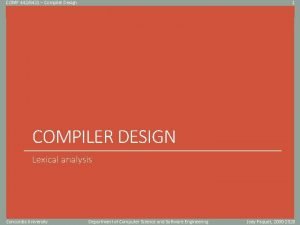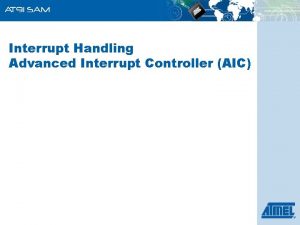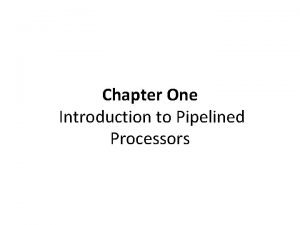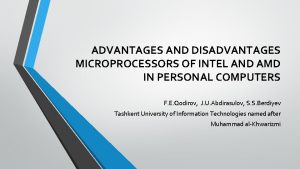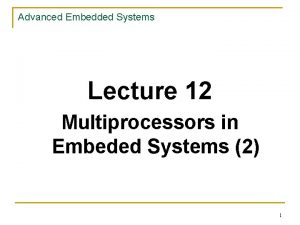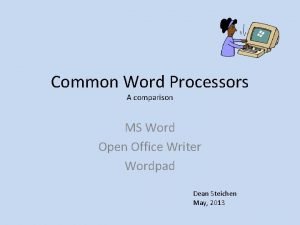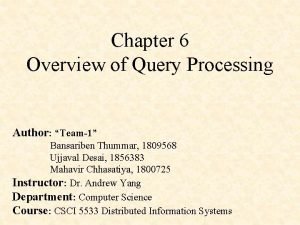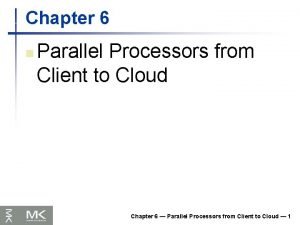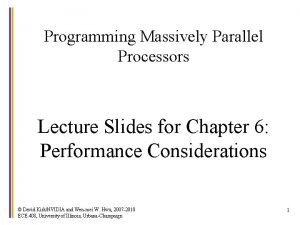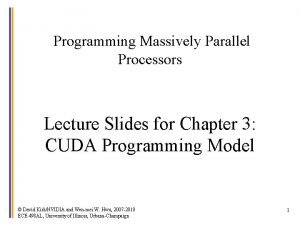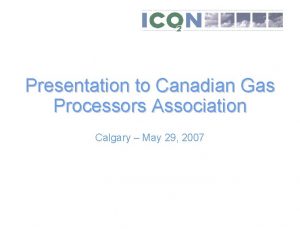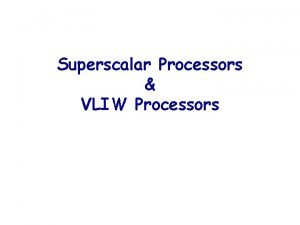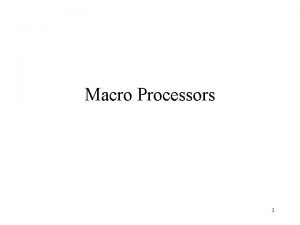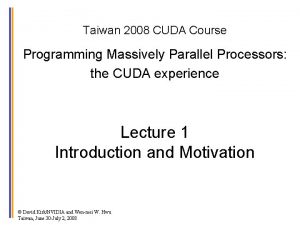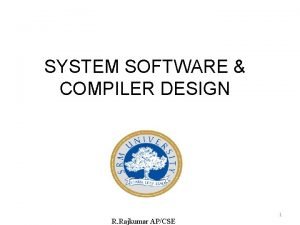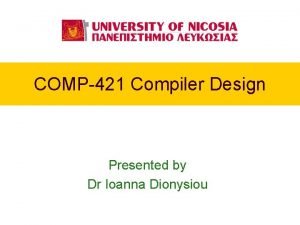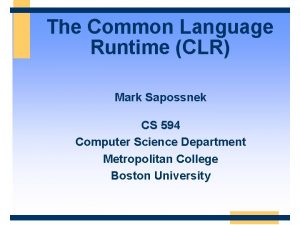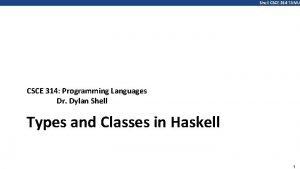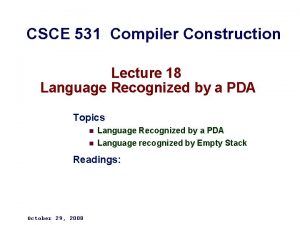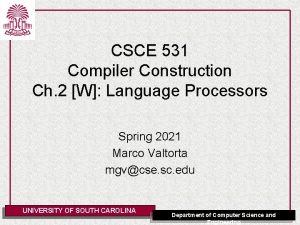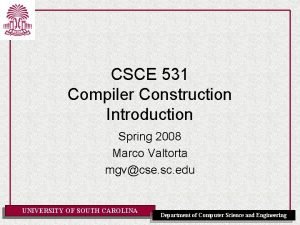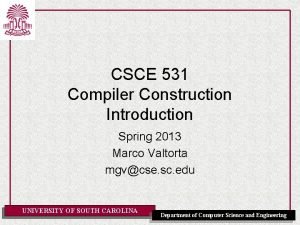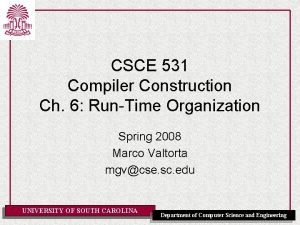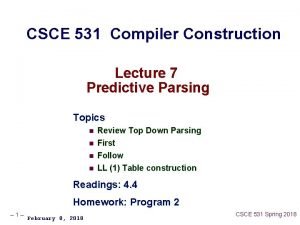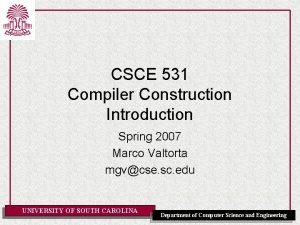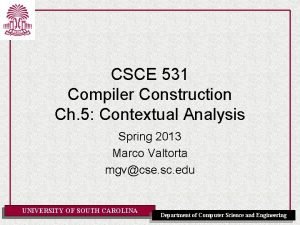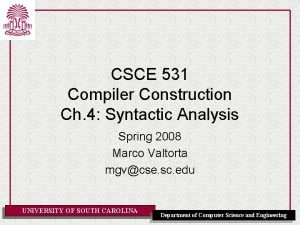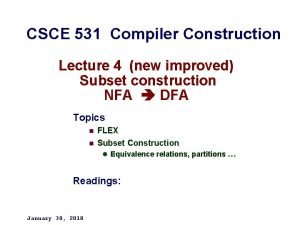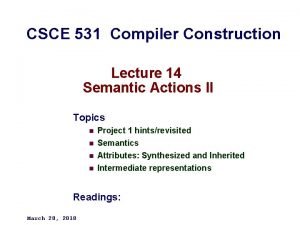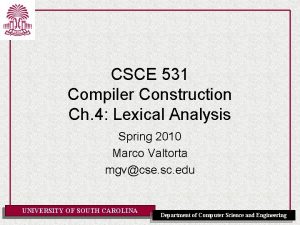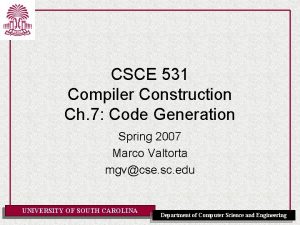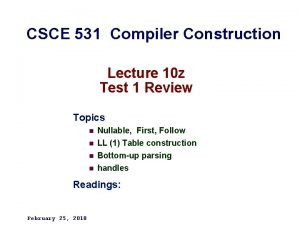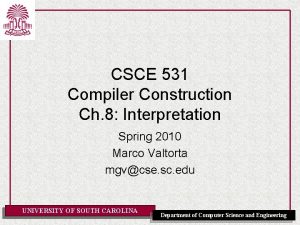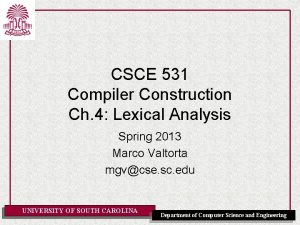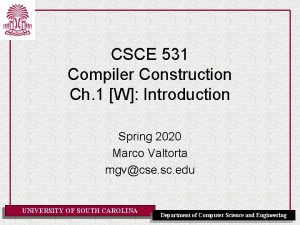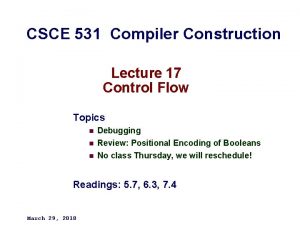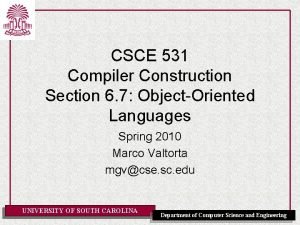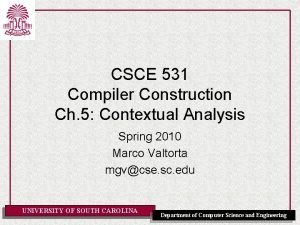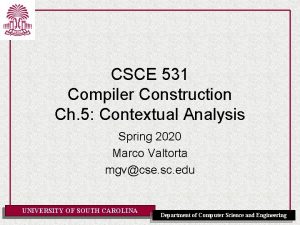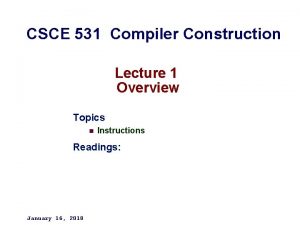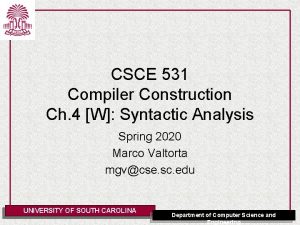CSCE 531 Compiler Construction Ch 2 Language Processors
















































- Slides: 48

CSCE 531 Compiler Construction Ch. 2: Language Processors Spring 2013 Marco Valtorta mgv@cse. sc. edu UNIVERSITY OF SOUTH CAROLINA Department of Computer Science and Engineering

Acknowledgment • The slides are based on the textbooks and other sources, including slides from Bent Thomsen’s course at the University of Aalborg in Denmark and several other fine textbooks • We will also use parts of Torben Mogensen’s online textbook, Basics of Compiler Design • The three main other compiler textbooks I considered are: – Aho, Alfred V. , Monica S. Lam, Ravi Sethi, and Jeffrey D. Ullman. Compilers: Principles, Techniques, & Tools, 2 nd ed. Addison-Welsey, 2007. (The “dragon book”) – Appel, Andrew W. Modern Compiler Implementation in Java, 2 nd ed. Cambridge, 2002. (Editions in ML and C also available; the “tiger books”) UNIVERSITY OF SOUTH CAROLINA Computer Science and Engineering – Grune, Dick, Henri E. Bal, Department Cerielof. J. H. Jacobs, and

Today’s lecture • Treating compilers and interpreters as blackboxes • Tombstone diagrams (T-diagrams) • Key reference: Jay Earley and Howard Sturgis. “A Formalism for Translator Interactions. ” Communications of the ACM, 607 -617, 13, 10 (October 1970). • Chapter 2 of textbook (“Language Processors”) UNIVERSITY OF SOUTH CAROLINA Department of Computer Science and Engineering

Language Translation • A programming language processor is any system that manipulates programs expressed in a PL • A source program in some source language is translated into an object program in some target language • Translators are assemblers or compilers • An assembler translates from assembly language to machine language • A compiler translates from a high-level language into a low -level language – the compiler is written in its implementation language • An interpreter is a program that accepts a source program and runs it immediately • An interpretive compiler translates a source program into an intermediate language, and the resulting object program is then executed by an interpreter UNIVERSITY OF SOUTH CAROLINA Department of Computer Science and Engineering

Example of Language Translators • Compilers for Fortran, COBOL, C, C++ • Interpretive compilers for Pascal (P-Code), Prolog (Warren Abstract Machine) and Java (Java Virtual Machine) • Interpreters for APL, Scheme, Haskell, Python, and (early) LISP UNIVERSITY OF SOUTH CAROLINA Department of Computer Science and Engineering

Terminology Q: Which programming languages play a role in this picture? input source program Translator is expressed in the source language A: All of them! output object program is expressed in the target language is expressed in the implementation language UNIVERSITY OF SOUTH CAROLINA Department of Computer Science and Engineering

Tombstone Diagrams What are they? • diagrams consisting out of a set of “puzzle pieces” we can use to reason about language processors and programs • different kinds of pieces – the base of the piece always contains the implementation language • combination rules (not all diagrams are “well formed”) Program P implemented in L P L Machine implemented in hardware M UNIVERSITY OF SOUTH CAROLINA Translator implemented in L S -> T L Language interpreter in L M L Department of Computer Science and Engineering

Tombstone diagrams: Combination rules P M M P L M P S OK! S -> T M M OK! P L WRONG! UNIVERSITY OF SOUTH CAROLINA P T OK! S -> T M Department of Computer Science and Engineering

Compilation Example: Compilation of C programs on an x 86 machine Tetris C C -> x 86 Tetris x 86 UNIVERSITY OF SOUTH CAROLINA Tetris x 86 Department of Computer Science and Engineering

What is Tetris? Tetris® The World's Most Popular Video Game Since its commercial introduction in 1987, Tetris® has been established as the largest selling and most recognized global brand in the history of the interactive game software industry. Simple, entertaining, and yet challenging, Tetris® can be found on more than 60 platforms. Over 65 million Tetris® units have been sold worldwide to date. UNIVERSITY OF SOUTH CAROLINA Department of Computer Science and Engineering

Cross compilation Example: A C “cross compiler” from x 86 to PPC A cross compiler is a compiler that runs on one machine (the host machine) but emits code for another machine (the target machine). Tetris C C -> PPC x 86 Tetris PPC download Tetris PPC Host ≠ Target Q: Are cross compilers useful? Why would/could we use them? UNIVERSITY OF SOUTH CAROLINA Department of Computer Science and Engineering

Two Stage Compilation A two-stage translator is a composition of two translators. The output of the first translator is provided as input to the second translator. Tetris Java->JVM JVM->x 86 x 86 UNIVERSITY OF SOUTH CAROLINA Department of Computer Science and Engineering

Compiling a Compiler Observation: A compiler is a program! Therefore it can be provided as input to a language processor. Example: compiling a compiler. Java->x 86 C -> x 86 C x 86 UNIVERSITY OF SOUTH CAROLINA Department of Computer Science and Engineering

Interpreters • An interpreter is a language processor implemented in software, which accepts any program (the source program) expressed in a particular language (the source language) and runs that source program immediately. • An interpreter works by fetching, analyzing, and executing the source program instructions, one at a time. The source program starts to run and produce results as soon as the first instruction has been analyzed. The interpreter does not translate the source program into object code prior to execution. However, • the analysis phase may involve local translation into a suitable intermediate representation • recursive interpreters may analyze the whole program before executing any instruction UNIVERSITY OF SOUTH CAROLINA Department of Computer Science and Engineering

Interpreters versus Compilers Q: What are the tradeoffs between compilation and interpretation? Compilers typically offer more advantages when – programs are deployed in a production setting – programs are “repetitive” – the instructions of the programming language are complex Interpreters typically are a better choice when – we are in a development/testing/debugging stage – programs are run once and then discarded – the instructions of the language are simple – the execution speed is overshadowed by other factors • e. g. on a web server where communications costs are much higher than execution speed UNIVERSITY OF SOUTH CAROLINA Department of Computer Science and Engineering

Interpreters Terminology: abstract (or virtual) machine versus real machine Example: The Java Virtual Machine Tetris JVM x 86 Q: Why are abstract machines useful? UNIVERSITY OF SOUTH CAROLINA Department of Computer Science and Engineering

Interpreters Q: Why are abstract machines useful? 1) Abstract machines provide better platform independence Tetris JVM x 86 UNIVERSITY OF SOUTH CAROLINA Tetris JVM PPC Department of Computer Science and Engineering

Interpreters Q: Why are abstract machines useful? 2) Abstract machines are useful for testing and debugging. Example: Testing the “Ultima” processor using hardware emulation P Ultima x 86 P Ultima Functional equivalence Note: we don’t have to implement Ultima emulator in x 86; we can use a high-level language and compile it. UNIVERSITY OF SOUTH CAROLINA Department of Computer Science and Engineering

Interpretive Compilers Why? A tradeoff between fast(er) compilation and a reasonable runtime performance. How? Use an “intermediate language” • more high-level than machine code => easier to compile to • more low-level than source language => easy to implement as an interpreter Example: A “Java Development Kit” for machine M Java->JVM M UNIVERSITY OF SOUTH CAROLINA Department of Computer Science and Engineering

Hybrid Compilation and Interpretation UNIVERSITY OF SOUTH CAROLINA Department of Computer Science and Engineering

UNIVERSITY OF SOUTH CAROLINA Department of Computer Science and Engineering

Interpretive Compilers Example: Here is how we use our “Java Development Kit” to run a Java program P P Java javac P Java->JVM M M UNIVERSITY OF SOUTH CAROLINA java P JVM M M Department of Computer Science and Engineering

Portable Compilers Example: Two different “Java Development Kits” Kit 1: Java->JVM M Kit 2: Java->JVM JVM M Q: Which one is “more portable”? UNIVERSITY OF SOUTH CAROLINA Department of Computer Science and Engineering

Portable Compilers In the previous example we have seen that portability is not an “all or nothing” kind of deal. It is useful to talk about a “degree of portability” as the percentage of code that needs to be re -written when moving to a dissimilar machine. In practice 100% portability is impossible. UNIVERSITY OF SOUTH CAROLINA Department of Computer Science and Engineering

Example: a “portable” compiler kit Portable Compiler Kit: Java->JVM Java Q: Suppose we want to run this kit on some machine M. How could we go about realizing that goal? (with the least amount of effort) Assume we already have a compiler for a high-level language, such as C, for machine M: C->M M UNIVERSITY OF SOUTH CAROLINA Department of Computer Science and Engineering

Example: a “portable” compiler kit Java->JVM Java Q: Suppose we want to run this kit on some machine M. How could we go about realizing that goal? (with the least amount of effort) JVM Java reimplement JVM C C->M JVM M UNIVERSITY OF SOUTH CAROLINA Department of Computer Science and Engineering

Example: a “portable” compiler kit This is what we have now: Java->JVM Java JVM M Now, how do we run our Tetris program? Tetris Java->JVM JVM M M UNIVERSITY OF SOUTH CAROLINA Tetris JVM M M Department of Computer Science and Engineering

Bootstrapping Remember our “portable compiler kit”: Java->JVM Java JVM M We haven’t used this yet! Java->JVM Java Same language! Q: What can we do with a compiler written in itself? Is that useful at all? UNIVERSITY OF SOUTH CAROLINA Department of Computer Science and Engineering

Bootstrapping Java->JVM Java Same language! Q: What can we do with a compiler written in itself? Is that useful at all? • By implementing the compiler in (a subset of) its own language, we become less dependent on the target platform => more portable implementation. • But… “chicken and egg problem”? How do to get around that? => BOOTSTRAPPING: requires some work to make the first “egg”. There are many possible variations on how to bootstrap a compiler written in its own language. UNIVERSITY OF SOUTH CAROLINA Department of Computer Science and Engineering

Bootstrapping an Interpretive Compiler to Generate M code Our “portable compiler kit”: Java->JVM Java JVM M Goal we want to get a “completely native” Java compiler on machine M P P Java->M Java M M M UNIVERSITY OF SOUTH CAROLINA Department of Computer Science and Engineering

Bootstrapping an Interpretive Compiler to Generate M code (first approach) Step 1: implement Java ->M Java by rewriting Java ->JVM Java Step 2: compile it Java->M Java->JVM JVM M M Step 3: Use this to compile again UNIVERSITY OF SOUTH CAROLINA Department of Computer Science and Engineering

Bootstrapping an Interpretive Compiler to Generate M code (first approach) Step 3: “Self compile” the Java (in Java) compiler Java->M Java M JVM M M This is our desired compiler! Step 4: use this to compile the P program P Java UNIVERSITY OF SOUTH CAROLINA Java->M P M M Department of Computer Science and Engineering

Bootstrapping an Interpretive Compiler to Generate M code (second approach) Idea: we will build a two-stage Java -> M compiler. P Java->JVM M M M We will make this by compiling Java->JVM UNIVERSITY OF SOUTH CAROLINA JVM->M M M P M To get this we implement JVM->M Java and compile it Department of Computer Science and Engineering

Bootstrapping an Interpretive Compiler to Generate M code (second approach) Step 1: implement JVM->M Java Step 2: compile it JVM->M Java->JVM JVM M M Step 3: compile this UNIVERSITY OF SOUTH CAROLINA Department of Computer Science and Engineering

Bootstrapping an Interpretive Compiler to Generate M code (second approach) Step 3: “Self compile” the JVM (in JVM) compiler JVM->M JVM M This is the second stage of our compiler! Step 4: use this to compile the Java compiler UNIVERSITY OF SOUTH CAROLINA Department of Computer Science and Engineering

Bootstrapping an Interpretive Compiler to Generate M code Step 4: Compile the Java->JVM compiler into machine code Java->JVM JVM->M M The first stage of our compiler! We are DONE! P Java->JVM M M M UNIVERSITY OF SOUTH CAROLINA JVM->M P M M M Department of Computer Science and Engineering

Comparison of approaches to bootstrapping an interpretive compiler (portable compiler kit) Java ->M Java ->JVM In approach by one, we Java rewriting implement JVM ->M Java ->JVM In approach by two, we Java rewriting implement In approach one, we Java->M obtain a one-stage M compiler P P P In approach Java->JVM JVM->M Java M two, we M M obtain a two. M stage M compiler UNIVERSITY OF SOUTH CAROLINA Department of Computer Science and Engineering

Full Bootstrap A full bootstrap is necessary when we are building a new compiler from scratch. One goal is to remove the dependence on a compiler for a different high-level language, even though such a compiler is very useful to start building the new compiler. Example: We want to implement an Ada compiler for machine M. We don’t currently have access to any Ada compiler (not on M, nor on any other machine). Idea: Ada is very large, so we will implement the compiler in a subset of Ada and bootstrap it from a compiler for a subset of Ada implemented in another language. (e. g. C) UNIVERSITY OF SOUTH CAROLINA Department of Computer Science and Engineering

Full Bootstrap Step 1 a: build a compiler (v 1) for Ada-S in another language v 1 Ada-S ->M C Step 1 b: Compile v 1 compiler on M v 1 Ada-S ->M Ada-S->M C M M M UNIVERSITY OF SOUTH CAROLINA This compiler can be used for bootstrapping on machine M but we do not want to rely on it permanently, since it is written in C, and we do not want to depend on the existence of C compilers. Department of Computer Science and Engineering

Full Bootstrap Step 2 a: Implement v 2 of Ada-S compiler in Ada-S v 2 Ada-S ->M Q: Is it hard to rewrite the compiler in Ada-S? Ada-S Step 2 b: Compile v 2 compiler with v 1 compiler v 2 v 1 Ada-S->M Ada-S ->M M We are now no longer dependent M on the availability of a C compiler! UNIVERSITY OF SOUTH CAROLINA Department of Computer Science and Engineering

Full Bootstrap Step 3 a: Build a full Ada compiler in Ada-S v 3 Ada->M Ada-S Step 3 b: Compile with v 2 compiler v 3 Ada->M v 2 Ada->M M Ada-S ->M M M From this point on we can maintain the compiler in Ada. Subsequent versions v 4, v 5, . . . of the compiler are written in the previous version of Ada UNIVERSITY OF SOUTH CAROLINA Department of Computer Science and Engineering

Half Bootstrap We discussed full bootstrap which is required when we have no access to a compiler for our language at all. Q: What if we have access to an compiler for our language on a different host machine HM but want to develop one for target machine TM ? We have: We want: Ada->HM Ada->TM HM Ada TM Idea: We can use cross compilation from HM to TM to bootstrap the TM compiler. UNIVERSITY OF SOUTH CAROLINA Department of Computer Science and Engineering

Half Bootstrap Idea: We can use cross compilation from HM to bootstrap the M compiler. Step 1: Implement Ada->TM compiler in Ada->TM Ada Step 2: Compile on HM Ada->TM Ada->HM HM UNIVERSITY OF SOUTH CAROLINA Cross compiler: running on HM but emits TM code Department of Computer Science and Engineering

Half Bootstrap Step 3: Cross compile our TM compiler. Ada->TM TM HM HM DONE! From now on we can develop subsequent versions of the compiler completely on TM UNIVERSITY OF SOUTH CAROLINA Department of Computer Science and Engineering

Bootstrapping to Improve Efficiency The efficiency of programs and compilers: Efficiency of programs: - memory usage - runtime Efficiency of compilers: - Efficiency of the compiler itself - Efficiency of the emitted code Idea: We start from a simple compiler (generating inefficient code) and develop more sophisticated version of it. We can then use bootstrapping to improve performance of the compiler. UNIVERSITY OF SOUTH CAROLINA Department of Computer Science and Engineering

We have: Bootstrapping to Improve Efficiency Ada->Mslow Ada-> Mslow Ada Step 1 We implement: Ada->Mfast Ada-> Mslow M Step 2 Ada->Mfast Ada-> Mfast Mslow Fast compiler that emits fast code! M UNIVERSITY OF SOUTH CAROLINA Department of Computer Science and Engineering

The Triangle Language Processor • The Triangle language processor includes a compiler, an interpreter, and a disassembler • The compiler and interpreter together constitute an interpretive compiler • TAM is an abstract machine • TAL (Triangle Assembly Language) is an abstract version of the machine language of the TAM Triangle->TAM Java UNIVERSITY OF SOUTH CAROLINA TAM->TAL Java Department of Computer Science and Engineering

Conclusion • • To write a good compiler you may be writing several simpler ones first You have to think about the source language, the target language and the implementation language. Strategies for implementing a compiler 1. Write it in machine code 2. Write it in a lower level language and compile it using an existing compiler 3. Write it in the same language that it compiles and bootstrap The work of a compiler writer is never finished, there is always version 1. x and version 2. 0 and … UNIVERSITY OF SOUTH CAROLINA Department of Computer Science and Engineering
 Yet another compiler compiler
Yet another compiler compiler Cross compiler in compiler design
Cross compiler in compiler design Language and processors for requirement
Language and processors for requirement 531 area code
531 area code Onap network slicing
Onap network slicing Cpsc 531
Cpsc 531 Cpsc 531
Cpsc 531 Cpsc 531
Cpsc 531 Cpsc 531
Cpsc 531 September 3, 1939
September 3, 1939 Wet purpura
Wet purpura Cse 531
Cse 531 Compiler construction principles and practice
Compiler construction principles and practice Types of type checking in compiler design
Types of type checking in compiler design Phases of compiler construction
Phases of compiler construction Front end and back end in compiler design
Front end and back end in compiler design Front end of compilers includes
Front end of compilers includes Preprocessor in compiler construction
Preprocessor in compiler construction Disadvantages of compiler
Disadvantages of compiler Compiler construction: principles and practice
Compiler construction: principles and practice Attributes of tokens in compiler design
Attributes of tokens in compiler design Thompson construction in compiler design
Thompson construction in compiler design Programming massively parallel processors
Programming massively parallel processors Non linear pipeline processors
Non linear pipeline processors Interrupt handling in arm processors
Interrupt handling in arm processors Processor history
Processor history Unifunction and multifunction pipeline
Unifunction and multifunction pipeline Digital camera processors
Digital camera processors Disadvantages of processor
Disadvantages of processor Embeded processors
Embeded processors Microcontrollers and embedded processors
Microcontrollers and embedded processors Comparison of word processors
Comparison of word processors Characteristics of query processor
Characteristics of query processor Parallel processors from client to cloud
Parallel processors from client to cloud Programming massively parallel processors
Programming massively parallel processors Massively parallel processing ppt
Massively parallel processing ppt Gas processors association
Gas processors association Gstreamer architecture
Gstreamer architecture Network systems design using network processors
Network systems design using network processors Two pass macro processor algorithm
Two pass macro processor algorithm Superscalar machine
Superscalar machine Macro processors are
Macro processors are Introduction to telecommunication
Introduction to telecommunication Programming massively parallel processors, kirk et al.
Programming massively parallel processors, kirk et al. The designer express the ideas in terms related to the
The designer express the ideas in terms related to the Activation tree in compiler design
Activation tree in compiler design Clr c#
Clr c# Csce 221 tamu syllabus
Csce 221 tamu syllabus Csce 314
Csce 314


